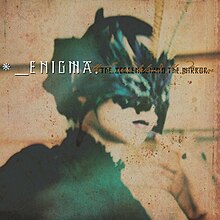The Screen Behind the Mirror
| The Screen Behind the Mirror | ||||
|---|---|---|---|---|
 |
||||
| Studio album by Enigma | ||||
| Released | January 14, 2000 | |||
| Recorded | A.R.T. Studios, Ibiza, 1999 | |||
| Genre | New-age, ambient | |||
| Length | 43:25 | |||
| Label | Virgin | |||
| Producer | Michael Cretu | |||
| Enigma chronology | ||||
|
||||
| Singles from The Screen Behind the Mirror | ||||
|
||||
| Professional ratings | |
|---|---|
| Review scores | |
| Source | Rating |
| allmusic | |
The Screen Behind the Mirror is the fourth studio album by Enigma. It is Enigma's fourth album. Recorded at the A.R.T. Studios in Ibiza, Spain, it was released worldwide by Virgin Records.
Supporters of the album credited it as the most mature album Michael Cretu had created, while critics lamented the use of extensive samples from Carl Orff's Carmina Burana, even though it only appears on four out of the eleven tracks on the album.
Heather Phares of AllMusic gave the album 2 (out of 5) stars stating "Though it doesn't reveal significant growth or change in Enigma's work, The Screen Behind the Mirror will please fans of the group's other atmospheric works."
"The Gate" begins the album with its trademark Enigma horn, fused together with Elisabeth Houghton narrating astronomical facts about the fourth planet from the sun, Mars, similar to the ending title track of Vangelis' album, Albedo 0.39. "O Fortuna, velut Luna, statu variabilis" cuts into it rather abruptly and loudly, and ends quickly for the voice to continue the recital unfazed, as it continues deep into the next song, "Push the Limits" for 24 seconds.
"Push the Limits" introduces first a high-paced beat, first some snare drums and then several other layers of music gradually to form a complex and multilayered track. Elisabeth Houghton whispers the lyrics to the song and this brings in a presumably mellow voice (Actually an electric guitar solo modified to sound so) throughout the slow centre of the track, and as the music picks up, Elisabeth whispers again and the soft moans of a girl enters. Further strong beats brings an end to this 6'26" track as it fades to silence, leaving a blurry mumble at the end of the song, and the beginning of the next one.
Chants of "O Fortuna, velut Luna" appears at the start of the next song, "Gravity of Love" as Ruth-Ann Boyle sings with sounds of "O Fortuna" in between. A woman and a man whispers a line each before Ruth-Ann resumes and "O Fortuna" comes in, following the same pattern. The beats of this track becomes more and more audible as each of the instruments fade away, and eventually it stops.
...
Wikipedia
